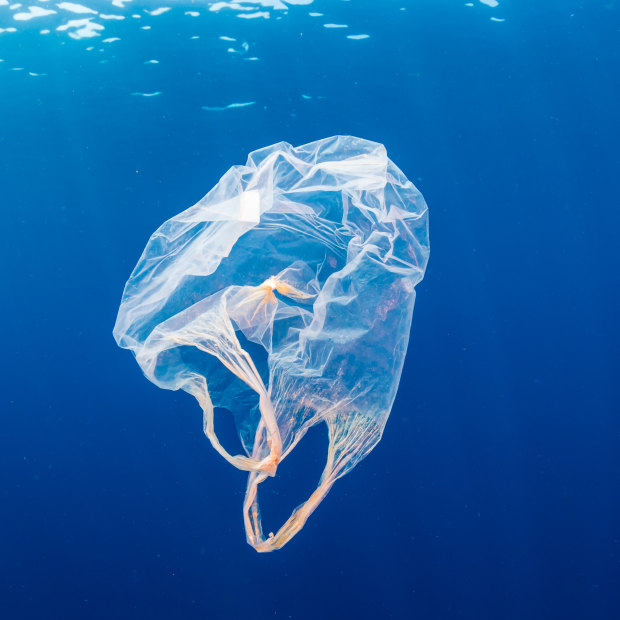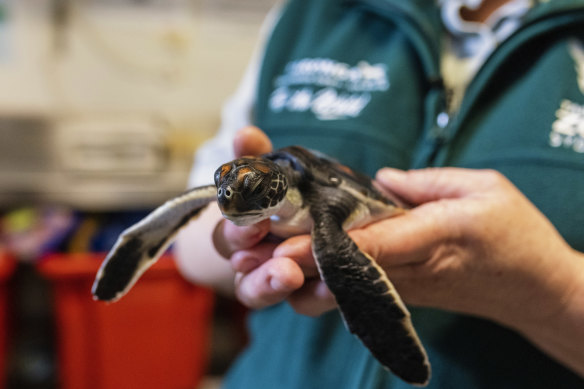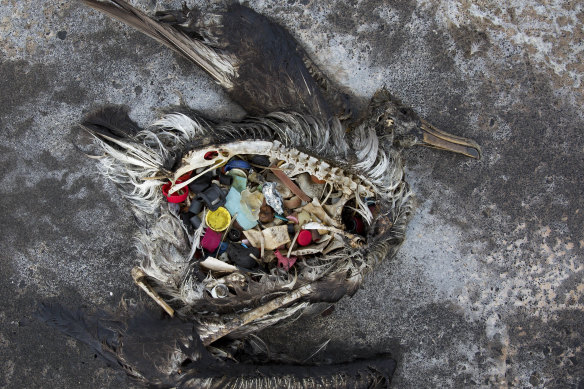
A single cucumber in a plastic sheath. Take-away coffee cups and lids. Fruit stickers. Fast food containers, slick with oil. Slippery, one-use produce bags. Online shopping packaging, plastic bottles, straws, bread bag fasteners … the list never ends.
The amount of plastic used and discarded in Australia each year is huge: about 3.4 million tonnes. And about 30 per cent of this is single-use plastics: flimsy items that we use briefly and then throw away. But they can take decades, if not centuries, to decompose.
Soon, this will change. On Tuesday, November 1, NSW will ban a number of single-use plastic items, following in the footsteps of Western Australia and South Australia. Victoria will do the same in February next year.
Half a dozen items – plastic drinking straws, cutlery, plates, drink stirrers, expanded polystyrene food and drink containers and cotton bud sticks – will no longer be available for purchase. (People who need single use straws for disability or medical reasons will still be able to buy them).
This change builds on bans of single-use plastic bags, which began 2016 and are now universal in Australia.
And other shifts are afoot – Coles supermarkets are currently running trials at 12 stores in the Australian Capital Territory by removing single-use fresh produce bags. But will these bans be enough to make any dent in our plastic addiction?
A plastic nation
Australians generate more single-use plastic waste per capita than any other country in the world – about 60 kilograms a year – followed closely by the US, according to research from the Minderoo Foundation. In contrast, the average person in China – the largest producer of single-use plastic by volume – generates 18 kilograms, while in India, that figure is only four kilograms a year. The global average is about 15 kilograms a year.
Each year, every person in Australia (on average) uses 45 plastic produce bags, 50 plastic straws, about 70 plastic cups for hot liquid and 35 for cold, according to this 2021 report commissioned by the Australian government. These single-use plastics make up about a third of the litter on the street.
And we use an extraordinary amount of plastic in packaging. In 2019-20, more than 3.4 million tonnes of plastic products were consumed in Australia. Of this, about 36 per cent went into packaging (i.e. single use), 25 per cent went into the “other application area”, which includes clothing and footwear, and household goods in general, and 22 per cent into the built environment.
So, what’s the plan?
As a group, Australia’s environment ministers have agreed on a list of eight problematic single-use plastic products for industry to phase out by 2025.
These include lightweight plastic bags, products misleadingly called “degradable”, plastic straws, utensils and stirrers, polystyrene food containers and packaging, and microbeads in personal health care products. Most states and territories have, or are about to, implement these bans through legislation.
In 2018, Australia established national packaging “targets” for 2025, supported by the packaging industry and national government. Within two years, these targets say, all of our packaging should be able to be reused, recycled or composted, and 70 per cent of plastic packaging should be recycled or composted (though it is unclear how they propose conventional plastic be composted). Is this realistic?
But these are only targets, not mandatory rules with an enforceable penalty. And we’re not close to meeting them anyway, says Kate Noble, the No Plastic in Nature policy manager at WWF Australia.
In the three years since the targets were introduced, the percentages of plastic products being recycled, or the recycled content of plastics, for example, hasn’t changed. We haven’t shifted the dial.

It’s taken six years but the plastic bag ban is now universal in Australia.Credit:
“We’re very concerned about Australia’s ability to meet those targets and the data shows our current voluntary targets aren’t driving the progress we need to see,” says Noble.
She wants Australia to make packaging targets compulsory and introduce similar guidelines to reduce plastic consumption and waste generation.
“There are a lot of recycling infrastructure projects in the pipeline which will help a bit, but we can’t recycle our way out of the mountain of plastic waste we’re creating. Reducing and re-using have to be our highest priority.”
Pooping plastic
Veterinary nurse Libby Hall was at work in May when a 127-gram green turtle hatchling was brought into Taronga Zoo’s wildlife shelter, in Sydney. The hatchling had been found at Tamarama beach with a missing flipper and a hole in its shell. And it had consumed so much plastic that when it arrived, it took six days to poop it all out.
“It’s hard to imagine how a small animal like that has seen so much plastic in its lifetime,” said Hall. “There’s so much plastic in the marine environment. I think the public would be surprised.”
Taronga sees about 40 turtles come to its wildlife shelter each year, and about 40 per cent of these would be injured by plastic. And there are seabirds and even terrestrial animals that get entangled in plastic, or eat it, believing it to be food. About 80 per cent of marine debris is estimated to come from the land and washed into the ocean through waterways.

Tamar the green turtle hatchling was pooping plastic for six days after he was found. Credit:Taronga Zoo
Hall has seen animals with ribbons from balloons, hard plastics, soft plastics, plastic bag and even biodegradable plastic bags in their stomachs. “Those biodegradable bags don’t break down in the ocean,” says Hall.
When Environment Minister Tanya Plibersek, launched the State of the Environment report shortly after Labor won the election, she said Australia’s oceans were experiencing a “plague of marine plastics”.
At least 14 million tons of plastic end up in the ocean every year, and it comprises a whopping 80 per cent of all marine debris, from surface waters to deep-sea sediments.
Where did all this plastic come from?
Plastic production began in earnest in World War II, when fighter pilots needed shatterproof plastic in their cockpits and plastic helmets and raincoats.
There are now more than 300 different types of plastics, that broadly fall into two groups: so-called synthetic plastics, synthesised from crude oil and liquid gas, and bio-based plastics, in which polymers are derived from cornflour and vegetable fats.

A black footed albatross chick with plastics in its stomach.Credit:AP
Only certain plastics can be melted down and made into new products, and most of what can be reused is “downcycled” – made into a poorer-quality product. A plastic bottle might get just two reincarnations before it has to be incinerated or tossed in landfill.
UNESCO says that generally takes between 500-1000 years for plastics to break down. Even then, they become microplastics, without fully degrading. Microplastics contaminate the entire planet, from Mount Everest to the deep oceans. They have been found in the faeces of babies and adults, breastmilk and human placentas. The long-term effects of microplastics is unknown.
Will a ban help?
Noble describes moves to ban single-use plastic items as the “low-hanging fruit”, an important first step towards a truly “circular” economy – one that keeps materials, products, and services in circulation for as long possible.
Loading
“We know these bans do change behaviour,” says Noble. “By increasing awareness of the problem of plastic pollution it has knock-on effects with people’s choices and can lead to more sustainable behaviours in other areas.”
Since 2016, when plastic bag bans came into effect, heavy-duty plastic bags and reusable bag volumes have increased, but because single-use plastic bag use dropped so much, there has been a net reduction in plastic bag consumption overall.
According to the federal environment department, single-use plastic bag consumption has fallen by 90 per cent since 2016-17, driven by bans in Western Australia and Queensland in 2018, and Victorian bans in 2019, and NSW in June this year.
Overseas, France’s comprehensive “anti-waste law” is often referred to as an example of ambitious action to cut plastic waste. It has committed to phasing out single-use plastic by 2040 and recycling all plastics by 2025.
Each year, Break Free From Plastic counts and documents the brands found in plastic waste to identify the corporations responsible for plastic pollution.
Its 2021 analysis found that the top plastic-polluting corporations included Coca-Cola, PepsiCo, Unilever, Nestle, Procter & Gamble, Mondelez International, Philip Morris International, Danone, Mars, and Colgate-Palmolive.
Loading
The Boomerang Alliance, an Australian not-for-profit working on waste minimisation and recycling, says our action urgently needs to be accelerated.
“Our organisations have nominated heavyweight plastics bags, coffee cups and lids and the lack of standards to eliminate greenwashing as critical and urgent issues,” says director Jeff Angel.
And he’s blunt about the national targets, including that 70 per cent of packaging should be recycled by 2025: “We’re not going to get there”.
Get to the heart of what’s happening with climate change and the environment. Our fortnightly Environment newsletter brings you the news, the issues and the solutions. Sign up here.









 Add Category
Add Category